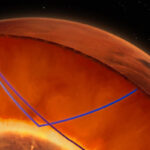Ancient river deposits exist across Mars and can be identified in satellite data by erosional landforms called fluvial ridges. Fluvial ridges take the shape of ancient river deposits, and are useful for understanding the history of water on the Red Planet. However, NASA’s Curiosity rover at Gale crater, Mars, has observed river deposits that are not associated with fluvial ridges, but rather bench- and nose-like landforms that are not generally associated with ancient river deposits. In a study published in the journal Geophysical Research Letters, planetary scientists modified a computer model that generates fluvial ridges from ancient river deposits by adding a preferred direction for scarp retreat, which may exist in craters on Mars because crater topography steers winds, and winds currently drive erosion on Mars. The model generated benches and noses rather than fluvial ridges, demonstrating that these landforms may be used as indicators of ancient river deposits in craters on Mars, similar to fluvial ridges.
Bench-and-slope morphology pictured on Mars (top) and nose morphology from the ground at Mars Mont Mercou outcrop (bottom). Image credit: NASA / Caltech-JPL / MSSS.
“We’re finding evidence that Mars was likely a planet of rivers. We see signs of this all over the planet,” Dr. Benjamin Cardenas, a researcher at the Pennsylvania State University.
“We have everything to learn about Mars by better understanding how these river deposits can be interpreted stratigraphically, thinking about rocks today as layers of sediment deposited over time.”
“This analysis is not snapshot, but a record of change. What we see on Mars today is the remnants of an active geologic history, not some landscape frozen in time.”
Prior studies of satellite data from Mars had identified erosional landforms called fluvial ridges as being possible candidates for ancient river deposits.
Using data collected by the Curiosity rover at Gale crater, Dr. Cardenas and his colleague, Dr. Kaitlyn Stacey, found signs of river deposits that are not associated with fluvial ridges, but rather bench-and-nose landforms that have never been linked to ancient river deposits.
“This suggests that there could be undiscovered river deposits elsewhere on the planet, and that an even larger section of the Martian sedimentary record could have been built by rivers during a habitable period of Mars history,” Dr. Cardenas said.
“On Earth, river corridors are so important for life, chemical cycles, nutrient cycles and sediment cycles. Everything is pointing to these rivers behaving similarly on Mars.”
In designing their computer model, the researchers found a new use for 25-year-old scans of Earth’s stratigraphy.
Collected by oil companies, the scans of beneath the Gulf of Mexico seafloor provided an ideal comparison to Mars.
The scientists simulated Mars-like erosion using the 3D scans of actual, recorded stratigraphy on Earth.
When they ran the simulation, the model revealed erosional Martian landscapes that formed topographic benches and noses, rather than fluvial ridges, appearing almost identical to landforms observed by the Curiosity rover inside the Gale crater.
“Our research indicates that Mars could have had far more rivers than previously believed, which certainly paints a more optimistic view of ancient life on Mars,” Dr. Cardenas said.
“It offers a vision of Mars where most of the planet once had the right conditions for life.”
_____
Benjamin T. Cardenas & Kaitlyn Stacey. Landforms Associated With the Aspect-Controlled Exhumation of Crater-Filling Alluvial Strata on Mars. Geophysical Research Letters, published online August 8, 2023; doi: 10.1029/2023GL103618




